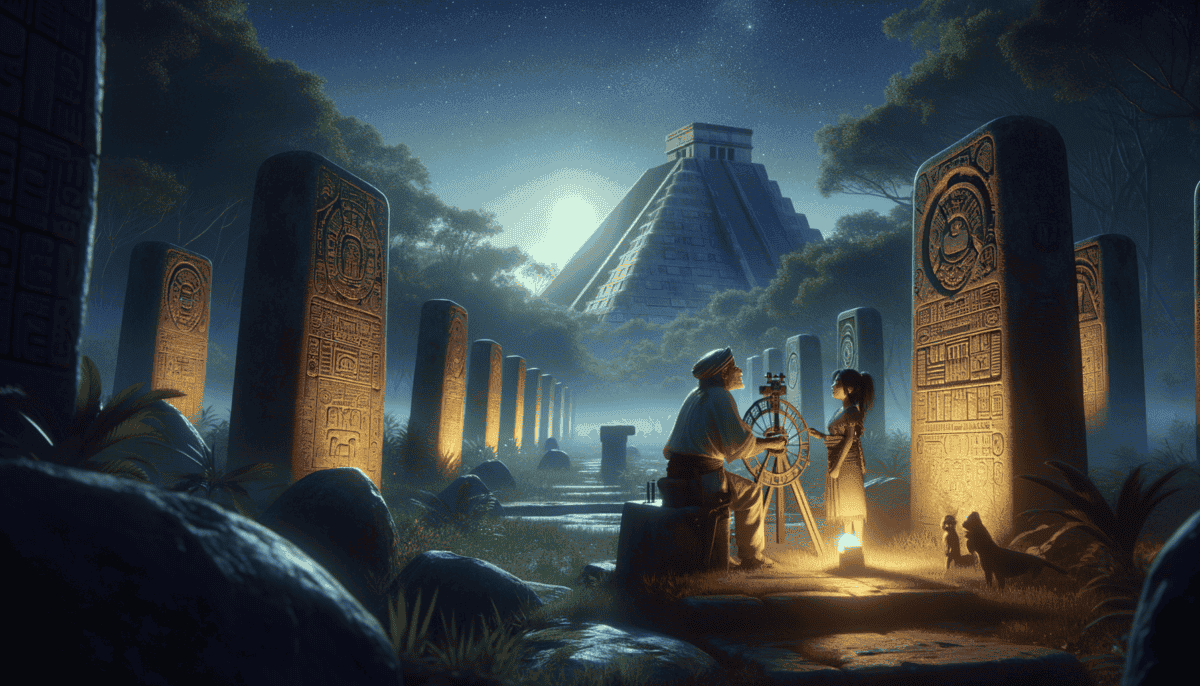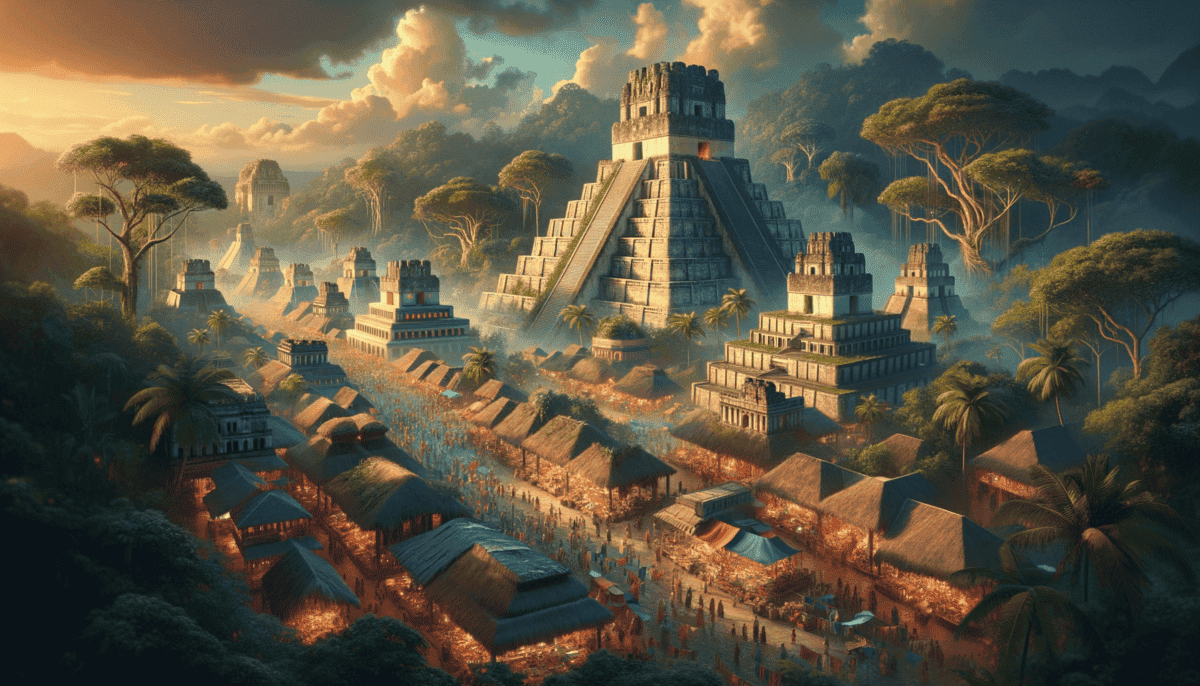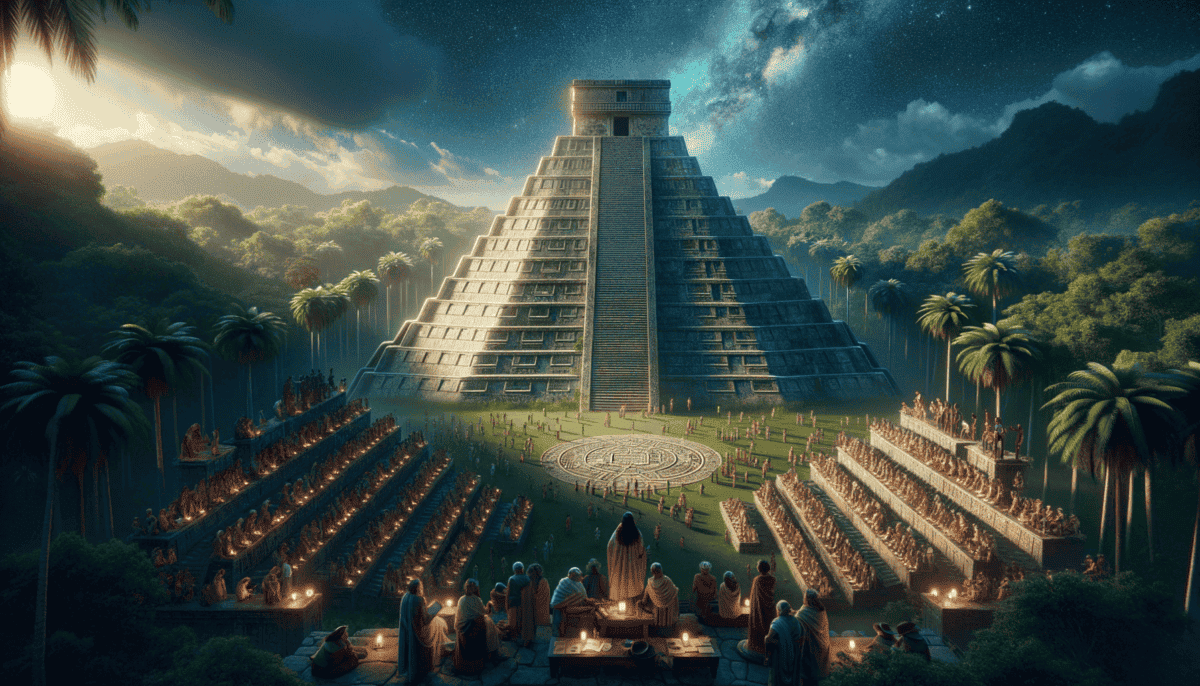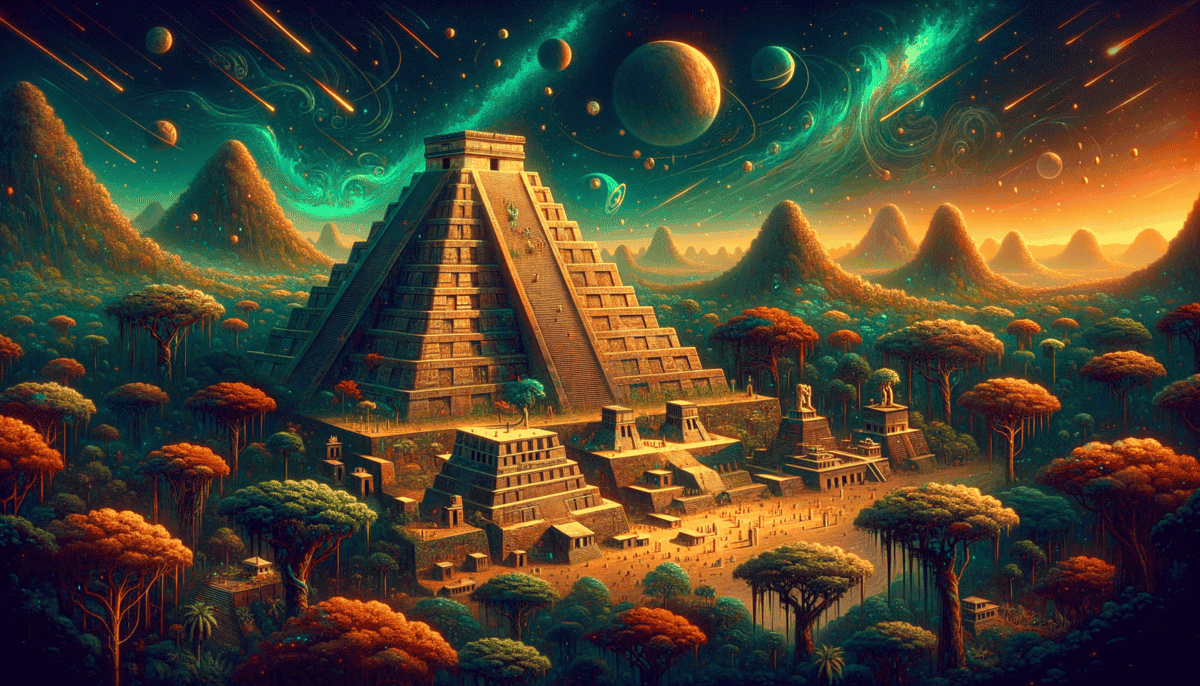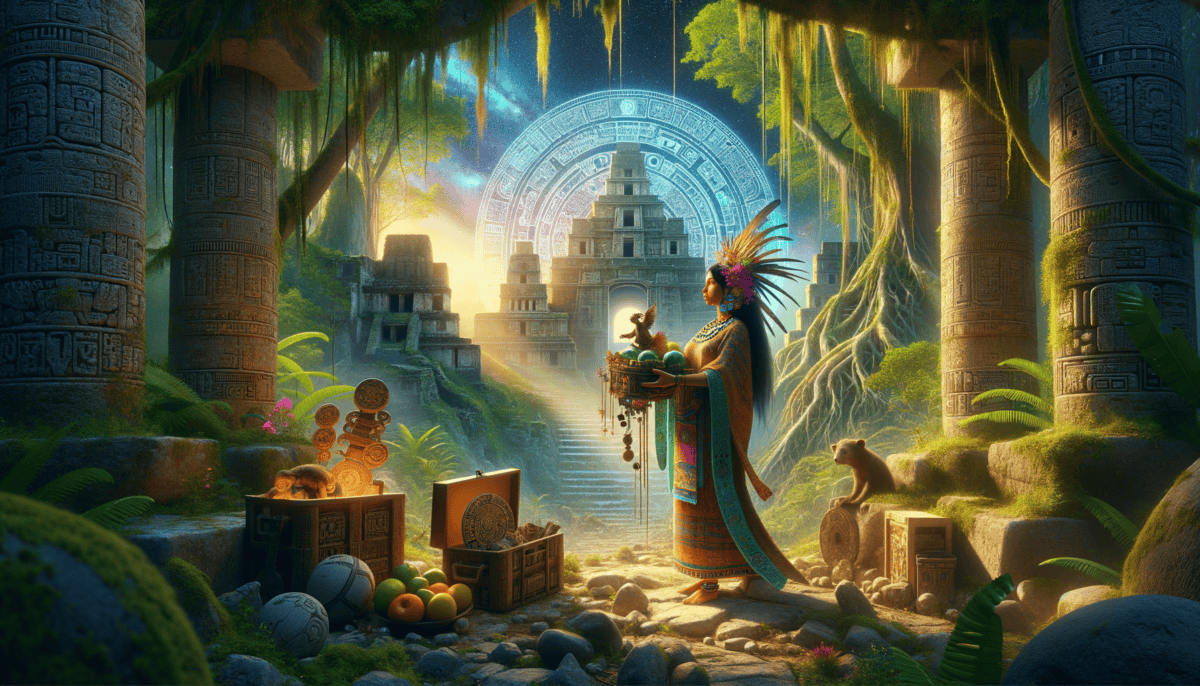Whispers of the Jungle
The morning sun peeked through the dense jungle canopy as Ixchel opened her eyes. She was eight years old, and like every child in her Maya village, she woke up excited for a new day of adventures.
Her small wooden home sat among tall ceiba trees. The sweet smell of corn tortillas filled the air as her mother worked at the cooking fire. Outside, birds sang their morning songs, and monkeys swung through the branches above.
"Good morning, little jaguar," her father called out with a warm smile. He used this special nickname because Ixchel was as curious and brave as the sacred jungle cat.
Ixchel ran her fingers through her long dark hair and joined her family for breakfast. Her mother handed her a warm corn tortilla filled with beans.
"Today is special," her mother said, her eyes twinkling. "You're old enough to help with the cacao trees."
Ixchel's heart jumped with joy. The cacao trees were precious to her people. Their beans made the most wonderful chocolate drink that even kings and priests enjoyed!
As they walked to the family's garden plot, Ixchel noticed how different plants grew together:
• Tall corn stalks reached for the sky
• Bean vines climbed up the corn
• Squash plants spread across the ground
• Cacao trees stood proud in the shade
"This is how our ancestors taught us to grow food," her father explained. "Each plant helps the others grow strong."
The jungle suddenly came alive with sounds. A toucan's call echoed through the trees, and a group of bright parrots flew overhead, their wings flashing green and red against the blue sky.
Ixchel watched as her parents carefully tended to the cacao pods. The trees needed special care – not too much sun, not too much shade. Her small hands helped collect fallen leaves to make the soil rich.
"Look!" she exclaimed, pointing to colorful glyphs carved into a nearby stone. The strange symbols told stories of her people's past.
Her father nodded proudly. "Those marks are our writing. They tell the story of how the gods gave us cacao. One day, you'll learn to read them too."
As the day grew warmer, more villagers emerged from their homes. Some carried clay pots to fetch water, while others headed to the fields with stone tools. Children played games with carved stones and balls made from tree sap.
"Why do we build such tall temples?" Ixchel asked, shading her eyes to look up at the massive structure.
Her mother smiled. "They bring us closer to the gods, little one. And from the top, our wise men can study the stars to know when to plant and harvest."
That evening, as the sun painted the sky orange and pink, Ixchel sat with her family around the cooking fire. The smell of spicy peppers and roasted corn filled the air. Her grandmother began telling stories about the gods who created their world.
"Tomorrow," her grandmother said with a mysterious smile, "I'll show you something special in the temple. It's time you learned more about our ways."
Ixchel could hardly wait. As she drifted off to sleep that night, the sounds of the jungle – crickets chirping and distant howler monkeys – made a peaceful lullaby. She dreamed of temples touching the stars and mysterious glyphs dancing in the moonlight.
Stargazers and Sacred Numbers
The temple steps seemed to go up forever. Ixchel followed her grandmother, counting each step as they climbed. The morning air was cool and misty.
“One, two, three…” Ixchel whispered, her small feet carefully finding each stone step.
“Do you know why we count, little one?” her grandmother asked, pausing to catch her breath.
At the top of the temple, Ixchel gasped. She could see everything – the jungle stretching out like a green blanket, other temples peeking through the trees, and the morning sky painted in beautiful colors.
“Look here,” her grandmother said, pointing to strange marks carved into the stone. “These are our numbers. Each dot means one, and each line means five.”
Ixchel traced the carvings with her finger. “But why do we need so many numbers?”
Her grandmother’s eyes twinkled. “To track time, little jaguar. To know when to plant, when to harvest, and when the rains will come.” ️
A tall man in a colorful headdress approached them. It was Ahau K’in, the temple’s timekeeper.
“Welcome, young one,” he said warmly. “Would you like to see how we read the stars?”
“Look through here,” he said, showing her a special tube. “When the morning star appears in this spot, we know it’s time to plant our corn.”
Ixchel learned that her people had many calendars:
- One for planting and growing food
- One for special ceremonies
- One that counted very long periods of time
“Our calendars are like a big story,” her grandmother explained. “They tell us when things happened in the past and what might happen in the future.”
As the sun climbed higher, more people came to the temple top. Some brought offerings of flowers and special corn cakes. Others came to ask Ahau K’in about good days for important events.
“When will the rains come?” a farmer asked.
Ahau K’in consulted his marks and calculations. “In thirteen days,” he answered confidently. “The stars tell us so.”
Ixchel watched in wonder as he showed her how to use shadows to tell time. “The sun is like a clock in the sky,” he explained, pointing to marks on the temple floor.
Later, her grandmother taught her a special counting game using colored beans. “This is how we learn our numbers,” she said. “Each color has a different value.”
That afternoon, they watched as priests used a special table to predict when the moon would be full. Ixchel learned that her people could even predict when the sun would go dark during special eclipses!
“Our ancestors watched the sky for hundreds of years,” Ahau K’in told her. “They wrote down everything they learned in books made of tree bark.”
As the day ended, Ixchel’s head was full of numbers and stars. Her grandmother hugged her close. “Tomorrow,” she whispered, “we’ll visit the great city of Tikal. There are even more wonders for you to see.”
That night, Ixchel dreamed of dancing stars and numbers that turned into butterflies. In her sleep, she counted the days until her next adventure, just as her ancestors had counted the movements of the stars.
City of Stone and Stories
The morning sun had barely risen when Ixchel and her grandmother started their journey to Tikal. The path through the jungle was filled with the sounds of birds and monkeys.
“Look!” Ixchel pointed to something through the trees. Rising high above the forest were giant stone buildings, their tops touching the clouds.
As they got closer, Ixchel’s eyes grew wide. The city was huge! People were everywhere, dressed in colorful clothes. Some wore beautiful jade necklaces and feathered headdresses.
“Who are all these people, grandmother?” Ixchel asked, staying close.
“Some are nobles who help run the city,” her grandmother explained. “Others are traders bringing goods from far away. See those people carrying shells? They walked all the way from the ocean!”
They passed through the marketplace, where the air was filled with wonderful smells:
- Sweet chocolate drinks
- Fresh corn tortillas
- Spicy peppers
- Colorful fruits
“Look at this!” A friendly trader showed Ixchel a shiny piece of jade. “This stone came from the mountains far away. We trade cacao beans for it.”
A group of children ran past, playing with a small rubber ball. “Can I play?” Ixchel asked.
“Later, little one,” her grandmother smiled. “First, we must visit someone important.”
They climbed steps to a beautiful building where a man sat on a decorated throne. He wore a jaguar skin and had a tall headdress with long green feathers.
“That’s the city’s ruler,” her grandmother whispered. “He makes sure everyone follows the laws and that the city runs smoothly.”
Ixchel watched as people brought gifts to the ruler – beautiful cloth, shiny shells, and precious jade jewelry. Each person bowed respectfully.
A scribe sat nearby, painting strange pictures on bark paper. “He’s writing down everything that happens today,” her grandmother explained. “These are our stories.”
Later, they visited craftspeople at work. Ixchel watched a potter shape clay into beautiful bowls. Another person carved detailed pictures into stone.
“Everyone has a job here,” her grandmother said. “Some grow food, others build houses, and some make beautiful things to trade.”
As the sun began to set, drums started beating. “What’s that?” Ixchel asked excitedly.
“It’s time for the evening ceremony,” her grandmother smiled. “But that’s another story for tomorrow.”
That night, as they rested in their borrowed house, Ixchel thought about everything she’d seen. The big buildings, the busy marketplace, and all the different people working together made her feel proud to be Maya.
Sacred Games and Hidden Meanings
The drums were still beating as Ixchel woke up the next morning in Tikal. Today was special – it was time for the sacred ball game!
“Come quickly!” her grandmother called. “We don’t want to miss anything!”
They joined the crowd walking to a big stone court. It had tall walls on both sides, shaped like the letter “I”. High up on the walls were stone rings.
“What are those for?” Ixchel asked, pointing to the rings.
“Watch and you’ll see,” her grandmother smiled. “The players have to get the ball through those rings – but they can’t use their hands!”
The players came out wearing thick padding. They looked like warriors in their colorful outfits and face paint. The crowd cheered loudly!
A priest in a jaguar mask held up a rubber ball. It was as heavy as a melon! He dropped it, and the game began.
The players moved like dancers. They hit the ball with their hips and knees, making it bounce high in the air. Sometimes they rolled on the ground to keep the ball from touching it.
“Look!” Ixchel jumped up and down. A player had just sent the ball through one of the stone rings! The crowd went wild.
After the game, everyone gathered for a big ceremony. Priests in beautiful feathered clothes danced and burned sweet-smelling copal incense.
“Why do we play this game, grandmother?” Ixchel asked.
“The ball game shows how life moves, like the sun and moon,” her grandmother explained. “It helps keep our world in balance.”
Later that day, they visited a temple where priests were writing in books made of bark paper. They used bright colors to paint stories about the gods and the stars.
One priest showed Ixchel how to count using dots and lines – the Maya way of writing numbers:
- A dot meant one
- A line meant five
- They could count really big numbers!
“Our numbers help us track time,” the priest said. “We know when to plant crops and when to hold ceremonies.”
That evening, Ixchel learned about the corn god from storytellers. They told tales about how corn was a gift from the gods, and why it was sacred.
“Remember these stories,” her grandmother said. “They teach us who we are and how to live in harmony with the world.”
As night fell, priests lit fires on top of the temples. The flames seemed to touch the stars, and Ixchel felt connected to something bigger than herself.
She thought about the ball game, the stories, and all the ceremonies she had seen. Everything had a special meaning, connecting the people to each other and to the gods.
But tomorrow would bring new worries. Dark clouds were gathering in the distance, and Ixchel could feel changes coming. ️
Dark Clouds Gather
The morning sun felt different today. Ixchel watched as people rushed around the marketplace of Tikal, worried looks on their faces.
“The rains are late again,” her grandmother said, looking at the dry fields. “This is the third season with too little water.”
“Why don’t we just ask the rain god for help?” Ixchel asked.
“We try, little one. The priests make offerings every day. But something is changing in our world.”
They walked through the city, passing empty water tanks. Usually, these tanks were full of rainwater. Now they held only dust. Ixchel saw long lines of people waiting to get water from the few wells that still had some.
“Look!” someone shouted. “Strangers from the north!”
A group of people Ixchel had never seen before entered the city. They wore different clothes and spoke a language she didn’t know.
“They come from far away,” her grandmother explained. “Their lands are even drier than ours. More and more people are moving, looking for food and water.”
That afternoon, Ixchel watched the priests climb the highest temple. They performed a special dance, asking the gods for rain. The whole city watched and hoped.
But the only clouds were dust clouds, blown in from the dry forests.
“What’s happening to the trees?” Ixchel asked, noticing many bare patches in the jungle.
“We need wood to make our buildings and cook our food,” her grandmother said sadly. “But we’ve cut down too many trees. Without them, the rain doesn’t come as much.”
Here are some changes Ixchel noticed in her city:
- Less food in the marketplace
- More people coming from other cities
- Fewer trees in the forest
- Empty water tanks
- Worried faces everywhere
That night, Ixchel couldn’t sleep. She heard grown-ups talking in worried voices about moving away from the city.
“But this is our home!” she said to her grandmother. “We can’t leave!”
“Sometimes, little one, we must change to survive. Our people are strong. We will find a way, even if it means starting over somewhere new.”
As Ixchel finally drifted off to sleep, she dreamed of rain falling on green forests. But when she woke up, the air was still dry, and more strangers were arriving at the city gates.
The Maya would need all their wisdom to face what was coming next.
A Light That Never Fades
The morning brought change to Tikal. Many families packed their belongings, ready to leave the city. Ixchel watched as her neighbors said goodbye.
“Where will everyone go?” Ixchel asked her grandmother.
“Some will go north to the mountains. Others will move closer to the sea. But remember, little one – wherever we go, we carry our knowledge with us.”
That afternoon, Ixchel’s family gathered in their courtyard. Her father pulled out the special bark paper books they had kept safe.
“These books hold our stories,” he said, carefully opening one. “They show how to read the stars, when to plant crops, and how to heal with plants. We must protect them.”
Here’s what the Maya saved and passed down:
- Star maps for farming
- Stories about their gods
- Medicine recipes
- Math and writing
- Building secrets
“But how will we remember everything?” Ixchel worried.
Her grandmother smiled and touched her heart. “We remember by teaching others. Just as I taught you about the stars, you will teach your children.”
The next day, before leaving Tikal, Ixchel visited her favorite spots one last time. The tall pyramids, the marketplace, the ball court – they would stay behind, but her memories would travel with her.
“Look how the sun hits the temple,” her grandmother pointed. “Our ancestors built it to mark the seasons. Wherever we go, the same sun will guide us.”
“Will we build new cities?” Ixchel asked.
“Yes, little one. Different perhaps, but still Maya. We will adapt, just as we always have.”
As they walked through the forest path leading away from Tikal, Ixchel noticed something amazing. New green shoots were pushing through the dry soil. Life was finding a way to continue.
Ixchel looked back at Tikal one last time. The great city might become quiet, but the Maya people would go on. They would build new homes, plant new gardens, and teach new generations.
“We are like stars,” her grandmother said softly. “Even when you can’t see us, we’re still there, shining bright.”
Years later, Ixchel would teach her own children about the stars, the calendar, and the wisdom of their ancestors. The Maya story didn’t end – it changed and grew, like a strong tree with deep roots and new branches reaching toward the sky.
And somewhere in the forests of Central America, Maya voices still sing ancient songs, count days with the old calendar, and tell stories of great cities that once touched the clouds. Their light shines on, as bright as ever. ⭐


